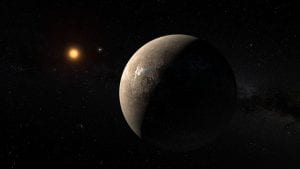Physics Professor Sheds Light on New Planet

Artist’s impression of the exoplanet Proxima Centauri b. The Alpha Centauri binary system can be seen in the background. (Credit: ESO/M. Kornmesser)
The discovery of the new exoplanet Proxima Centauri b seems like a story out of a science fiction novel – maybe because it actually is. The plot of science fiction author Stephen Baxter’s 2015 book Proxima is about an expedition to the actual red dwarf star Proxima Centauri and the colonization of an Earth-sized planet orbiting it.
Joseph Harrington, Ph.D., planetary scientist and professor in the UCF Department of Physics decided that it was time to start listening to the audiobook when a study published in Nature on August 24 detailed the discovery of a potentially habitable exoplanet that almost exactly mirrors the description of the planet in the novel. The recently discovered planet is optimal in the same ways as the planet in Proxima – except this one is real.
“It’s not just a coincidence,” Dr. Harrington said. “Proxima b is the planet that you would invent to be both easiest to observe and easiest to get to. This is the ultimate planet – we could not have asked for a better planet to study in hopes of finding a habitable environment or even life.”
Dr. Harrington has been asked to join the discovery team to help them measure the planet directly, a topic he discussed recently with Orlando’s NPR station, WMFE.
The discovery of the new planet stemmed from seeing back and forth shifting in the star’s spectrum.
Both a planet and its star orbit around a center point known as their mutual center of mass. A small Earth-sized planet like Proxima b has a much wider orbit around this point than does its star. Proxima b was discovered because Proxima Centuari also circles this point, causing a back and forth shift in its spectrum.
Dr. Harrington said that the time it takes to shift back and forth once – the planet’s year – and the fact that it is orbiting a red dwarf star, determines both the planet’s distance from the star and its temperature.
Although it is 4.2 light-years away, Proxima Centauri is the closest star to our sun. Proxima b orbits around it in what Dr. Harrington calls the “Goldilocks zone,” a zone that is neither too hot nor too cold for a planet to potentially contain liquid water.
“It is at an appropriate temperature for having liquid water on the surface,” Dr. Harrington said. “That’s why this discovery is so exciting.”
All of these specifics work out to mean that outside of our solar system, Proxima b is the closest planet to Earth that could possibly foster life.
No one has actually seen the planet yet – only its influence on the star, Dr. Harrington said. He is now focusing on observations that will detect the planet directly.
Dr. Harrington’s research team is currently looking for transits, which are instances when a planet orbits in front of a star. They do not know if Proxima b actually transits at this point – and it might not at all.
“The likelihood of it transiting is very low, only around 1 percent,” Dr. Harrington said. “But if it does transit, it opens up a whole new set of observations that we can do. If it doesn’t transit then at least we know we have to focus on other methods.”
While the possibility for Proxima b to fail to transit is also present, Dr. Harrington is willing to take the risk.
